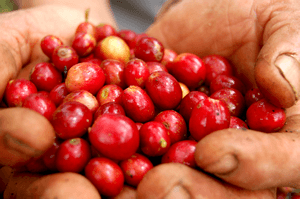Third-wave coffee facts for kids
Third-wave coffee is a way of thinking about coffee that focuses on making it super high quality. It means getting coffee beans from specific farms. These beans are roasted lightly to show off their special tastes. Even though the name was first used in 1999, this idea of high-quality coffee started back in the 1970s.
Contents
History of Coffee Waves
The name 'third-wave coffee' was first used by a coffee expert named Trish Rothgeb in 2003. She was thinking about how there are different 'waves' or periods in history. Another coffee expert, Timothy Castle, had used the term even earlier, in 1999. The idea became more widely known around 2005.
First Wave: Simple Coffee
In the first wave of coffee, people usually didn't care where their coffee came from. They just wanted a cheap and consistent cup. Think of instant coffee or the coffee you'd get at a diner. Many restaurants even offered free refills!
Second Wave: New Flavors and Drinks
The second wave of coffee began in the late 1960s with places like Peet's Coffee in California. They started buying special beans and roasting them carefully. They focused on where the coffee came from and often used a dark roast. Starbucks was inspired by Peet's Coffee.
This wave taught people that coffee could taste different depending on its origin. For example, coffee from Colombia tasted different from coffee from Brazil. People also started to love coffee from high up in the mountains, especially a type called Coffea arabica. Each country's coffee had its own special flavors. The second wave also brought popular Italian coffee drinks, like those made with espresso, to more people.

Third-wave coffee is often linked to 'specialty coffee'. This term can mean very high-quality green (unroasted) coffee beans. It can also mean fancy coffee drinks made with great care.
Third Wave in the UK
In the late 1900s, instant coffee was very popular in the UK. Then, places like Seattle Coffee Company opened in London in 1995, inspired by Starbucks. Later, in 2005, an early third-wave café called Flat White opened. James Hoffmann opened his third-wave coffee roasting company, Square Mile, in 2008.
From 2007 to 2009, people from London won the World Barista Championship. James Hoffmann was one of them. He is now seen as a leader in the third-wave coffee movement in the UK. Some even call him "the godfather of London's coffee revolution."
What the Term Means
Newspapers and magazines like The New York Times and The Guardian have written about the third wave of coffee.
In 2008, a food writer named Jonathan Gold explained it well:
The first wave of American coffee was when everyone drank simple coffee like Folgers. The second wave, starting in the 1960s, brought us places like Peet's Coffee and Starbucks with their espresso drinks and coffee from different regions. Now, we are in the third wave. Here, coffee beans come from specific farms, not just countries. Roasting is about making the unique flavors of each bean stand out, not burning them. The taste is clean and pure.
The term "specialty coffee" was first used in 1974. It means high-quality beans that score 80 points or more out of 100.
Today's Third-Wave Coffee
Across the US and Canada, many companies roast their own third-wave coffee. Some are small coffee shops, while others are larger. Three well-known third-wave coffee companies are Intelligentsia Coffee & Tea (from Chicago), Stumptown Coffee Roasters (from Portland, Oregon), and Counter Culture Coffee (from Durham, North Carolina). These companies often buy coffee directly from farmers.
Intelligentsia has several coffee bars in Chicago and Los Angeles. Stumptown has bars in many cities, including Portland, Seattle, and New York. Counter Culture has training centers where people learn about coffee. These are not regular stores. Compared to these, Starbucks has over 23,000 cafes worldwide!
In 2015, Peet's Coffee & Tea bought both Intelligentsia Coffee & Tea and Stumptown Coffee Roasters. Other important third-wave coffee companies at that time included Philz Coffee, Verve Coffee Roasters, and Blue Bottle Coffee.
In 2014, Starbucks also invested in a special coffee roastery and tasting room in Seattle. They wanted to get into the third-wave market. However, most Starbucks cafes use automatic espresso machines. These are faster and easier to use than the traditional machines that third-wave coffee shops often prefer.

